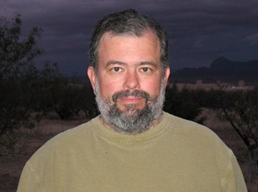Biographies:
 Dr. Emilio Falco, PhD MIT has been an Astronomer with SAO since 1989 and Project Director at FL Whipple Observatory since 2000. He works on several projects including the installation and use of new telescopes dedicated to the study of extrasolar planets. MEarth and HATs are examples that have been very successful in finding extrasolar planets and other transient phenomena. The latest addition is MINERVA (MINiature Exoplanet Radial Velocity Array), with four 0.7m telescopes and MINERVA Red with a single 0.7m telescope. The project started operations in 2015. Its primary science goal is to discover Earth-like planets in close-in (less than 50-day) orbits around nearby stars, and super-Earths (3-15 times the mass of Earth) in the habitable zones of the closest Sun-like stars.
Dr. Emilio Falco, PhD MIT has been an Astronomer with SAO since 1989 and Project Director at FL Whipple Observatory since 2000. He works on several projects including the installation and use of new telescopes dedicated to the study of extrasolar planets. MEarth and HATs are examples that have been very successful in finding extrasolar planets and other transient phenomena. The latest addition is MINERVA (MINiature Exoplanet Radial Velocity Array), with four 0.7m telescopes and MINERVA Red with a single 0.7m telescope. The project started operations in 2015. Its primary science goal is to discover Earth-like planets in close-in (less than 50-day) orbits around nearby stars, and super-Earths (3-15 times the mass of Earth) in the habitable zones of the closest Sun-like stars.
In his own words, some of the projects Dr. Falco is currently working on.
“I conduct gravitational lensing studies in several areas, from microlensing to quasar strong lensing to weak cluster lensing. Currently, I am pursuing multi-wavelength analyses of gravitational lens systems using Magellan/MMIRS infrared spectra of lensed quasars to measure spectral line widths and use them to measure black hole masses. I use the FLWO 1.2m to monitor gravitationally lensed quasars.
With the FLWO 1.5m, I take spectra of supernovae found with the All-Sky Automated Survey for Supernovae (ASAS-SN). The project, started by colleagues at OSU, uses eight 14cm telescopes, four at Haleakala, Hawaii, four at Cerro Tololo in Chile. It is designed to monitor the entire extragalactic sky every 2 days, with a primary goal to find all the nearest supernovae (SNe) with an unbiased search. The technique is very successful, having found 250 SNe in 2 years. It is assembling a complete census of local SNe.
Closer to earth, I have worked with several groups in the installation and use of new telescopes dedicated to the study of extrasolar planets. MEarth and HATs are examples that have been very successful in finding extrasolar planets and other transient phenomena. The latest addition is MINERVA (MINiature Exoplanet Radial Velocity Array), with four 0.7m telescopes and MINERVA Red with a single 0.7m telescope. The project started operations in 2015. Its primary science goal is to discover Earth-like planets in close-in (less than 50-day) orbits around nearby stars, and super-Earths (3-15 times the mass of Earth) in the habitable zones of the closest Sun-like stars. A secondary goal is to look for transits (eclipses) of known and newly-discovered extrasolar planets, which provide information about the radii and interior structures of the planets. This second goal uses the proven method used by the Kepler Mission.
Currently, I direct the operations of all the Ridge telescopes (1.5m, 1.2m, MEarth, HATs and MINERVA).”
 Alexandra Terry recently came on-board as the Public Relations Specialist at FLWO in March 2017. She has served in various capacities for Southern Arizona tribes for 16 years including Public Information Office and Chief of Staff for the Chairman of the Tonono O’odham Nation, most recently as Deputy Director of Housing for TON. Ms. Terry graduated with a BA in International Relations, Economic Development from Brown University and MBA from UofA.
Alexandra Terry recently came on-board as the Public Relations Specialist at FLWO in March 2017. She has served in various capacities for Southern Arizona tribes for 16 years including Public Information Office and Chief of Staff for the Chairman of the Tonono O’odham Nation, most recently as Deputy Director of Housing for TON. Ms. Terry graduated with a BA in International Relations, Economic Development from Brown University and MBA from UofA.
